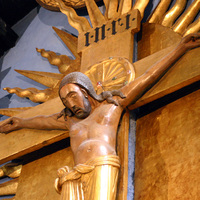Gero Cross
Type:
Sculptures,
Crosses
Date:
969–76
Location or Findspot (Modern-Day Country):
Germany
Medium:
Wood
Dimensions:
Height of 1.88 m
Description:
This painted oak depiction of Christ on the cross is an early example of this type of life-size crucifixion sculpture (only the Volto Santo in Lucca predates it). In the Byzantine world, three-dimensional religious imagery had been condemned at the Second Council of Nicaea (787), and so there was no tradition of depicting Christ in the round. The so-called Gero Cross (or Gero Crucifix) was commissioned by Archbishop Gero of Cologne (r. 969–76). Like later sculpted crucifixes designed for church interiors, it has a compartment for a relic. It is notable not only for its early date but also for its depiction of a slumped, dead Christ on the cross rather than Christ gazing forward triumphantly or down at the Virgin. This choice emphasizes Christ's humanity and vulnerability, in keeping with a renewed tenth-century interest in Christ's death and its role in salvation. Although the outer layer of paint was added in the early twentieth century, x-ray technology has confirmed that the eyes on the original tenth-century sculpture were also closed.
Relevant Textbook Chapter(s):
6
Repository and Online Resources:
• The Gero Cross is still in Cologne Cathedral.
• Explore Cologne Cathedral in 360-degree views and see the Gero Crucifix in its current location.
Image Credits:
Wikimedia Commons



